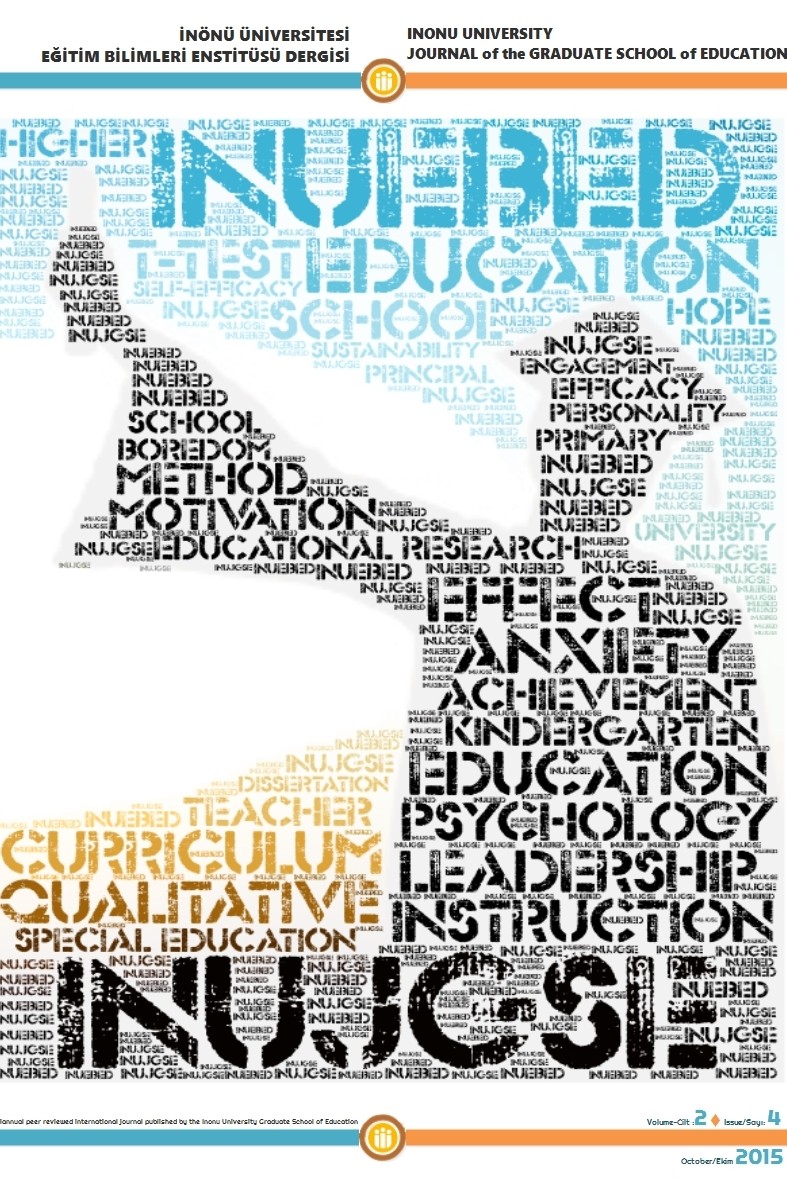Ergenlerde Akran İlişkilerinin Mutluluk Düzeyine Etkisi
Bu araştırmanın amacı ergenlerde akran ilişkilerinin mutluluğa etkisini incelemektir. Bu genel amaç doğrultusunda akran ilişkilerinin mutluluğa etkisini inceleyen hipotetik model test edilmiştir. Araştırma 84’ü (%51.9) kız, 78’i (%48.1) erkek olmak üzere 162 ergen üzerinde yürütülmüştür. Araştırmada veri toplama aracı olarak Akran İlişkileri Ölçeği (AİÖ) ve Oxford Mutluluk Ölçeği Kısa Formu (OMÖ-K) kullanılmıştır. Model, Yapısal Eşitlik Modellenmesi ile test edilmiştir. Analiz sonucunda akran ilişkilerinin mutluluğu doğrudan, pozitif yönde ve anlamlı düzeyde yordadığı görülmüştür. Bu sonuç ergenlerde akran ilişkilerinin mutluluğu arttıran bir faktör olduğunu göstermektedir.
Anahtar Kelimeler:
Akran ilişkileri, mutluluk, ergen
Effects of Peer Relations to Happiness in Adolescents
The aim of this study is to investigate the effects of peer relationships in adolescents to happiness. In line with this general purpose, hypothetical model which examining the effects of peer relations to happiness was tested. Research was conducted on 162 adolescents, 84 of whom (51.9%) were female and 78 (48.1%) of whom were male. Peer Relationship Scale (PRS) and Oxford Happiness Questionnaire Short Form (OHQ-S) were used as data collection tools. The model was tested by Structural Equation Modelling. In the result of analysis, it was seen that peer relations predict happiness in direct, positive and significant level. This result indicates that peer relations is a factor to increase happiness in adolescents.
Keywords:
peer relationship, happiness, adolescent,
___
- Arnett, J. (1992). Socialization and adolescent reckless behavior: A reply to Jessor. Developmental Review, 12, 391-409.
- Atik, Z. E., Çoban, A. E., Çok, F., Doğan, T., & Karaman, N. G. (2014). Akran ilişkileri ölçeğinin Türkçe’ ye uyarlanması: Geçerlik ve güvenirlik çalışması. Kuram ve Uygulamada Eğitim Bilimleri, 14(2), 433-446.
- Atkinson, R. L., Atkinson, R. C., Smith, E. U., & Bem, D. J. (1993). Introduction to psychology. Fort Worth, TX.
- Azmitia, M., Perlmutter, M. (1989). Social influences on children's cognition: State of the art and future directions. In Reese, H. W. (ed), Advances in child development and behavior. New York: Academic Press.
- Berk, E. B. (1998). Development through the lifespan. Boston: Allyn and Bacon.
- Brennan, T.(1982) Loneliness at adolescence. In Peplau, L. A., & Perlmann, D.(Eds), Loneliness: A sourcebook of current theory, research anda therapy. Wiley, New York
- Carlo, G., & Randall, B. A. (2001). Are all prosocial behaviors equal? A socioecological developmental conception of prosocial behavior. New Yorks: Nova Science.
- Coie, J., & Dodge, K. (1998). Aggression and antisocial behaviour. Handbook of child. New York: Wiley.
- Connell, J. P., & Wellborn, J. G. (1991). Competence, autonomy, and relatedness: A motivational analysis of self-system processes. Hillsdale, NJ: Erlbaum.
- Delikara, İ. E. (2000). Ergenlerin akran ilişkileri ve suç kabul edilen davranışlar arasındaki ilişkinin incelenmesi. (Yüksek lisans tezi). Ankara Üniversitesi, Sosyal Bilimler Enstitüsü, Ankara.
- Diekstra, R., & Garreski, N. (1996). Perceived social support from family, school, and peers: Relationship with emotional and behavioral problems among adolescents. Journal of the American Academy of Child and Adolescent Psychiatry, 35, 1657-1664.
- Doğan, T., & Çötok, N. A. (2011). Oxford mutluluk ölçeği kısa formunun Türkçe uyarlaması: Geçerlik ve güvenirlik çalışması. Türk Psikolojik Danışma ve Rehberlik Dergisi, 36(4), 165-170.
- Eisenberg, N., & Fabes, R. A. (1998). Prosocial development. Handbook of child psychology. New York: Wileys.
- Goldstein, S. E., Davis-Kean, P. E., & Eccles, J. S. (2005). Parents, peers, and problem behavior: a longitudinal investigation of the impact of relationship perceptions and characteristics on the development of adolescent problem behavior. Developmental Psychology, 41, 401-413.
- Jaccard, J., Blanton, H., & Dodge, T. (2005). Peer infl uences on risk behavior: An analysis of the effects of a close friend. Developmental Psychology, 41, 135-147.
- Kalkan, M., & Kaygusuz, C. (2013). İnternet bağımlılığı sorunlar ve çözümler. Ankara: Anı Yayıncılık.
- Köknel, Ö. (1991). Gençlik çağında kız-erkek arkadaşlığı. Aile yazıları 3. Ankara: T.C. Başbakanlık Aile Araştırma Kurumu Başkanlığı Yayınları.
- Kumru, A., Carlo, G., & Edwards, C. P. (2004). Olumlu sosyal davranışların ilişkisel, kültürel, bilişsel ve duyuşsal bazı değişkenlerle ilişkisi. Türk Psikoloji Dergisi, 54, 109-125.
- Meriç, B. (1999). Grup içinde popüler olan gençlerin bazı kişilik özellikleri üzerine bir inceleme. (Yüksek lisans tezi). Marmara Üniversitesi, Sosyal Bilimler Enstitüsü, İstanbul.
- Mounts, N. S. (2001). Young adolescents’ perceptions of parental management of peer relationships. Journal of Early Adolescence, 21, 92-122.
- Mounts, N. S. (2002). Parental management of adolescent peer relationships in context: the role of parenting style. Journal of Family Psychology, 16, 58-69.
- Nangle, D. W., & Erdley, C. A. (2001). Editors’ notes. In D. W. Nangle & C. A. Erdley (Series Eds.) & W. Damon (Volume Ed.), New directions for child and adolescent development. The role of friendship in psychological adjustment (Vol. 91, pp. 1-4). San Francisco: Jossey-Bass.
- Oberle, E., Schonert-Reichl, K. A., & Thomson, K. C. (2010). Understanding the link between social and emotional well-being and peer relations in early adolescence: Gender-specific predictors of peer acceptance. Journal of Youth and Adolescence, 39(11), 1330-1342.
- Tilton-Weaver, L. C. & Galambos, N. L. (2003). Adolescents’ characteristics and parents’ beliefs as predictors of parents’ peer management behaviors. Journal of Research on Adolescence, 13, 269-300.
- Wentzel, K. R. (1994). Relations of social goal pursuit to social acceptance, classroom behavior, and social support. Journal of Educational Psychology, 86, 173-186.
- Yörükoğlu, A. (1996). Çocuk ruh sağlığı. İstanbul: Özgür Yayınları.Darity, W. ve Goldsmith, A. H. (1993). Unemployment, social psychology, and unemployment hysteresis. Journal of Post Keynesian Economics, 16(1), 55-71.
- Yayın Aralığı: Yılda 2 Sayı
- Başlangıç: 2014
- Yayıncı: İnönü Üniversitesi
